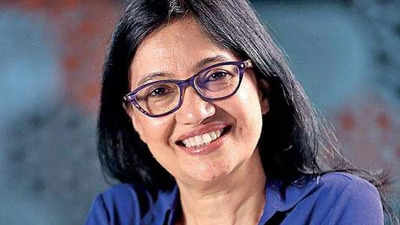- News
- Business News
- India Business News
- Intel India pilots internet over power lines
Trending
This story is from December 13, 2021
Intel India pilots internet over power lines
Nivruti Rai, country head of Intel India, says the company has piloted a project in India called WoW, or Wireless over Wire, that takes internet through electricity wires. Given that most villages have electricity connections, this could be a big breakthrough in making the internet available to remote areas if the technology is proved viable. Laying optical fibre to all villages is expensive and will take a long time. Some, like Elon Musk’s Starlink, are trying to achieve the same objective with satellites.

Nivruti Rai, country head of Intel India
BENGALURU: Nivruti Rai, country head of Intel India, says the company has piloted a project in India called WoW, or Wireless over Wire, that takes internet through electricity wires. Given that most villages have electricity connections, this could be a big breakthrough in making the internet available to remote areas if the technology is proved viable. Laying optical fibre to all villages is expensive and will take a long time.Some, like Elon Musk’s Starlink, are trying to achieve the same objective with satellites.

“Wherever there is electricity, we have a scalable, affordable way where we can provide data (through electricity wires) to the village. And from the village to the homes, it could be Wi-Fi,” Rai says. The middle mile, she says, is what is being solved. Optical fibre is available till the panchayat level. The major hurdle has been the segment from the panchayat to the village.
Data over power lines has challenges. They are more susceptible to external interference than when passed through optical fibre. It has to be seen how well Intel has overcome those.
“My goal is bigger than me, bigger than Intel, it’s for India. Because, if 600,000 villages are connected with data, if they have access to the global market, India grows, and we grow with them,” Rai says.
The WoW programme is part of a larger Intel initiative where it’s working with industry, academia, and government for AI development and deployment across sectors. As part of that, it recently held the second edition of all.ai, a global 24-hour marathon summit spanning five continents, including India. Last year, Intel established an applied AI research centre called INAI in collaboration with PHFI (Public Health Foundation of India), IIIT-Hyderabad, and the Telangana government.
Data, Rai says, is a precious commodity, especially if it is clean, annotated and contextualised. “That’s what we are building with INAI. And, we will be offering solutions, technologies and partnerships through our programmes and create value out of India for the world,” she says.
Recently, in partnership with Mahindra, Nagpur Municipal corporation, and CSIRCRRI, INAI has launched a programme called iRaste in Nagpur. “Leveraging the power of AI, we aim to achieve up to 50% decline in road accidents in Nagpur city, and create a blueprint to Vision Zero for the country,” Rai says.
Intel, Rai says, is also pushing AI through skilling. The company has trained 200,000 kids under the Intel AI for Youth programme.

“Wherever there is electricity, we have a scalable, affordable way where we can provide data (through electricity wires) to the village. And from the village to the homes, it could be Wi-Fi,” Rai says. The middle mile, she says, is what is being solved. Optical fibre is available till the panchayat level. The major hurdle has been the segment from the panchayat to the village.
Data over power lines has challenges. They are more susceptible to external interference than when passed through optical fibre. It has to be seen how well Intel has overcome those.
The concept of broadband over power lines is similar to the way telephone lines carry both voice and data by splitting the line into separate channels. Low-frequency electric signals carry ordinary phone calls and higher-frequency signals carry internet data. In the case of electricity lines, while the lower-frequency, alternating current carries electric power, a high-frequency signal carries the broadband data. The power outlet at the receiving point will require some modification so that the different signals are carried to the respective devices.
“My goal is bigger than me, bigger than Intel, it’s for India. Because, if 600,000 villages are connected with data, if they have access to the global market, India grows, and we grow with them,” Rai says.
The WoW programme is part of a larger Intel initiative where it’s working with industry, academia, and government for AI development and deployment across sectors. As part of that, it recently held the second edition of all.ai, a global 24-hour marathon summit spanning five continents, including India. Last year, Intel established an applied AI research centre called INAI in collaboration with PHFI (Public Health Foundation of India), IIIT-Hyderabad, and the Telangana government.
Data, Rai says, is a precious commodity, especially if it is clean, annotated and contextualised. “That’s what we are building with INAI. And, we will be offering solutions, technologies and partnerships through our programmes and create value out of India for the world,” she says.
Recently, in partnership with Mahindra, Nagpur Municipal corporation, and CSIRCRRI, INAI has launched a programme called iRaste in Nagpur. “Leveraging the power of AI, we aim to achieve up to 50% decline in road accidents in Nagpur city, and create a blueprint to Vision Zero for the country,” Rai says.
Intel, Rai says, is also pushing AI through skilling. The company has trained 200,000 kids under the Intel AI for Youth programme.
End of Article
FOLLOW US ON SOCIAL MEDIA















